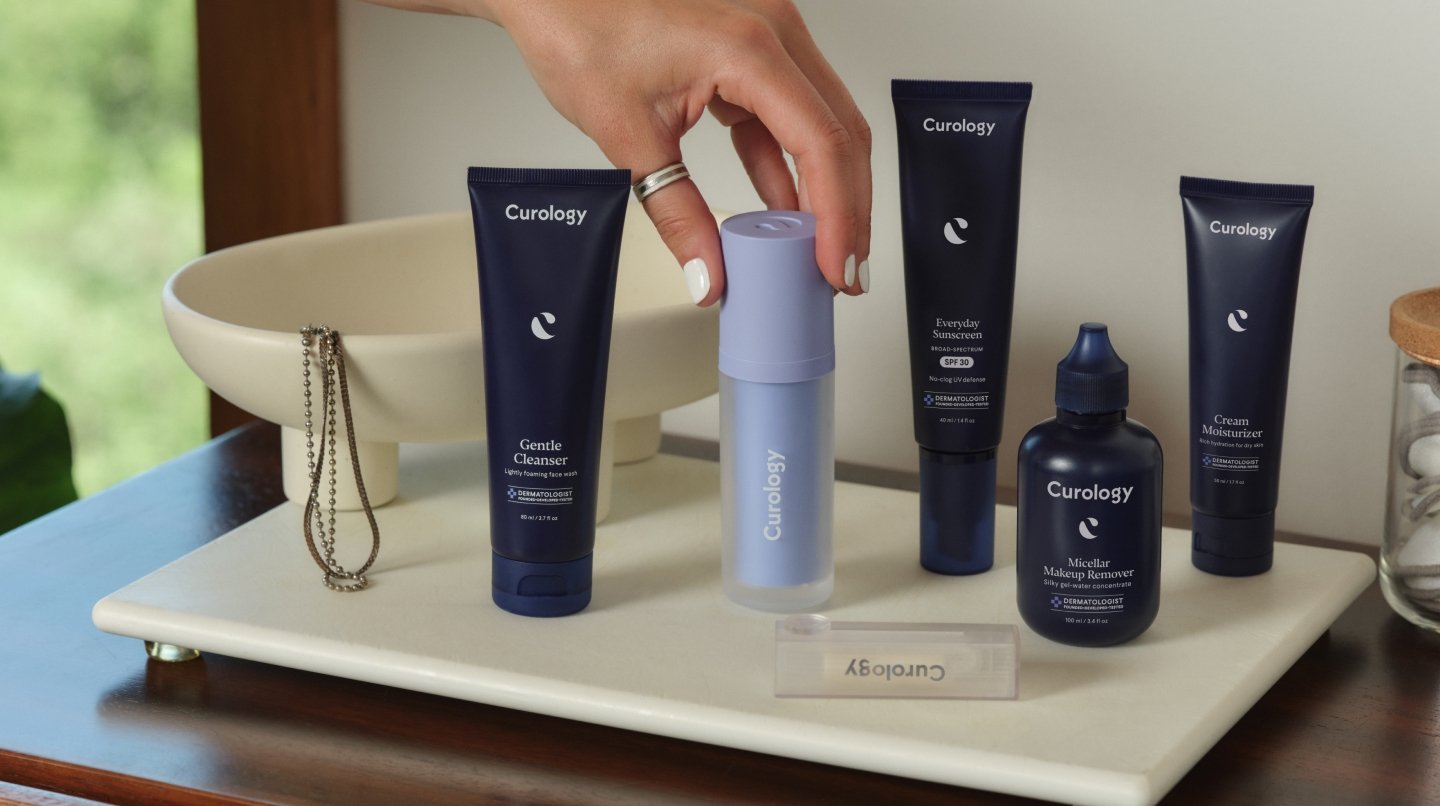How it works:
Share your skin goals and snap selfies
Your dermatology provider prescribes your formula
Apply nightly for happy, healthy skin
How it works:
How it works:
Share your skin goals and snap selfies
Your dermatology provider prescribes your formula
Apply nightly for happy, healthy skin
How it works:
Unlock the skin benefits of red light therapy
This trendy treatment may have an impressive array of benefits.



Achieving glowing and healthy skin is a process that can involve all sorts of products and treatments—and one treatment growing in popularity is red light therapy. It’s generally considered a safe and effective tool that can help people on their skincare journey by improving the appearance and overall health of their skin. By emitting red wavelengths of light, this innovative therapy may reduce the signs of aging, treat acne, and soothe inflammation.
That said, it can seem a bit futuristic and a bit like magic. When it comes to your skin health, we believe that knowledge is power—so here, our team of licensed dermatology providers will explain everything you need to know about red light therapy and how it may benefit your skin.
What is red light therapy?
Red light therapy is a type of treatment that uses red or near-infrared light to stimulate cells in your body and promote healing. This therapy is sometimes called photobiomodulation, and it works by absorbing light energy into your cells, which can have several benefits.
There is evidence that it can help reduce oxidative stress (reducing free radicals that can harm the body, including the skin), treat acne, and promote hair growth. This demonstrates that there is a need for larger studies to help us better understand the potential benefits of these therapies.¹
Since the 1950s, hospitals have used ultraviolet and red light therapy to treat dermatological conditions. Red light therapy has also been used for conditions like smallpox scarring.²
Light therapy can be used to help reduce pain and inflammation, promote tissue repair and new blood vessel generation, and enhance bone formation.³ More recently, light therapy has been used in innovative ways to support cancer care, help treat depression, and for complications after cardiac surgery.⁴
Research has found that red light therapy has the potential to rejuvenate skin.⁵
What is red light therapy used for?
Red light therapy is adopted by medical professionals and individuals to help address a range of conditions, including acne, psoriasis, scarring—as well as to help reduce the skin's signs of aging.
Acne
Red light is a promising treatment option for people with acne who have not responded to standard topical and oral medications. It may be used alongside long-term topical acne therapies, and may be a good alternative for patients who cannot tolerate oral pharmacological therapies.⁶
Existing evidence supports the use of red light therapy as a potentially useful treatment alternative for patients with acne.⁷
Psoriasis
Psoriasis is a chronic skin condition that causes skin cells to build up, resulting in thick, scaly patches on the skin's surface. It is often accompanied by itching, burning, and pain, which can significantly impact a person's quality of life.⁸
The use of red and blue lights in psoriasis treatment has shown promise in reducing inflammation and promoting collagen production.⁹ LED therapy can be used alone or in conjunction with other treatments to improve the appearance and health of psoriatic skin. Although studies have been promising, further research is needed to fully understand the effectiveness of LED therapy in psoriasis treatment.
Scarring
In a case study, facial wounds due to a car accident were healed with a combination of red light and other therapies.¹⁰ By increasing blood flow to the affected area, red light therapy can speed up the healing process, reduce soreness, and alleviate swelling and redness.¹¹ While more studies are needed, light therapy offers some potential for wound healing.
Aging
Low-level laser light therapy that targets skin cells may effectively reduce signs of aging skin, such as fine lines, creases, changes in pigmentation, spider veins, sun spots, and uneven texture. Parts of the skin absorb the light emitted by the LED device, resulting in the breakdown of old collagen and the stimulation and production of new collagen fibers, resulting in rejuvenated skin. Compared to other methods of rejuvenation like non-ablative and ablative thermal, LED therapy is less painful and requires less downtime.¹²
Is red light therapy safe?
Red light therapy has been shown to be a generally safe and effective treatment for mild to moderate inflammatory skin conditions and other dermatological concerns. It may provide patients with a faster resolution and fewer side effects compared to some other options.
If you are getting an in-office procedure done, it’s important to discuss the potential side effects with your dermatology provider. While we do not currently encourage the purchase of at-home devices, if you choose to use one, be sure to follow the manufacturer’s instructions.
When considering red light therapy as a treatment for skin concerns, it's important to consult with a medical provider to determine whether it's the right option for you. While red light therapy has been shown to be effective for a variety of skin issues, including acne and wrinkles, it may not be suitable for everyone.
Additionally, it's crucial to protect skin from the sun's harmful rays, whether undergoing red light therapy or not. Using a broad-spectrum sunscreen with a minimum SPF of 30, like The Sunscreen by Curology, can help prevent damage from UVA and UVB radiation. This is especially important for those undergoing any kind of treatment that may make the skin more sensitive.
Consulting with a licensed professional and taking steps to protect skin from the sun can help ensure the best possible results from red light therapy treatments while minimizing the risk of adverse effects.

Skincare solutions for your concerns
While it may not be suitable for everyone, red light therapy can be a good fit for some who wishes to improve skin health and boost confidence, ultimately leading to an overall sense of well-being. However, as everyone’s skin is different, it is important to consult with a licensed medical provider before undergoing red light therapy.
Get your personalized skincare routine with Curology
Get your personalized skincare routine with Curology


If you have skin concerns you’d like to target, get started with Curology to have a consultation with one of our licensed dermatology providers. Sign up for a 30-day trial* to experience the benefits of personalized skincare solutions.
FAQs
Red light therapy has gained traction in recent years due to its ability to address a wide range of skin concerns associated with aging. It has shown some results in clinical studies, and it has emerged as a promising non-invasive option for managing wrinkles, acne, and other signs of aging.
By utilizing specific wavelengths, red-light therapy devices stimulate cellular activity and promote collagen production, which in turn helps to improve skin texture, reduce inflammation, and restore a more youthful appearance.¹³
Red light therapy has been shown in studies to have less side effects compared to other treatment options.¹⁴
P.S. We did the homework so you don't have to:
Glass, G.E. Photomodulation: The Clinical Applications of Low-Level Light Therapy. Aesthetic Surgery Journal. (2021, January 20).
Liebert, A. and Kiat, H. The history of light therapy in hospital physiotherapy and medicine with emphasis on Australia: Evolution into novel areas of practice. Physiotherapy Theory and Practice. (2021, March 7).
Rohringer, S., et al. The impact of wavelengths of LED light-therapy on endothelial cells. Scientific Reports. (2017, September 6).
Liebert, A. and Kiat, H. The history of light therapy in hospital physiotherapy and medicine with emphasis on Australia: Evolution into novel areas of practice. Physiotherapy Theory and Practice. Ibid.
Glass, G.E. Photomodulation: The Clinical Applications of Low-Level Light Therapy. Aesthetic Surgery Journal. Ibid.
Zeitouni, N.C., et al. Photodynamic Therapy with 5-aminolevulinic Acid 10% Gel and Red Light for the Treatment of Actinic Keratosis, Nonmelanoma Skin Cancers, and Acne: Current Evidence and Best Practices. J Clin Aesthet Dermatol. (October 2021).
Zeitouni, N.C., et al. Photodynamic Therapy with 5-aminolevulinic Acid 10% Gel and Red Light for the Treatment of Actinic Keratosis, Nonmelanoma Skin Cancers, and Acne: Current Evidence and Best Practices. J Clin Aesthet Dermatol. Ibid.
Korman, N.J. Management of psoriasis as a systemic disease: what is the evidence?. British Journal of Dermatology. (2020, April 1).
Ngoc, L.T.N., et al. Utilization of light‐emitting diodes for skin therapy: Systematic review and meta-analysis. Photodermatology, Photoimmunology & Photomedicine. (2022, October 31).
Li, X., et al. Treatment of Wound Healing with Sequential Therapy to Accelerate Recovery and Inhibit Scar Hyperplasia: A Case Report. Clin Cosmet Investig Dermatol. (2021, July 6).
Li, X., et al. Treatment of Wound Healing with Sequential Therapy to Accelerate Recovery and Inhibit Scar Hyperplasia: A Case Report. Clin Cosmet Investig Dermatol. Ibid.
Ngoc, L.T.N., et al. Utilization of light‐emitting diodes for skin therapy: Systematic review and meta-analysis. Photodermatology, Photoimmunology & Photomedicine. Ibid.
Avci, P., et al. Low-level laser (light) therapy (LLLT) in skin: stimulating, healing, restoring. Semin Cutan Med Surg. (March 2013).
Avci, P., et al. Low-level laser (light) therapy (LLLT) in skin: stimulating, healing, restoring. Semin Cutan Med Surg. Ibid.
Meredith Hartle is a board-certified Family Medicine physician at Curology. She earned her medical degree at Kirksville College of Osteopathic Medicine in Kirksville, MO. *Cancel anytime. Subject to consultation. Results may vary.

Curology Team

Meredith Hartle, DO
Related Articles
Men skin care: top concernsHow to get rid of body and back acne?Wrinkles and other signs you’re doing it rightWhat is micellar water and how can you use it effectively?The science behind our skincare quiz: why it worksPopular Articles
Ask Curology: Is my cold breaking me out?Slugging: The dermatologist-approved skincare hack going viral on TikTokTretinoin vs retinol: What’s the difference?How to create a self-care routine that actually sticksYour 2023 skincare horoscopeTry prescription skincare
Get routine essentials

Good skin days ahead
- Breakouts
- Redness
- Fine lines
- Dark spots
- Hair thinning